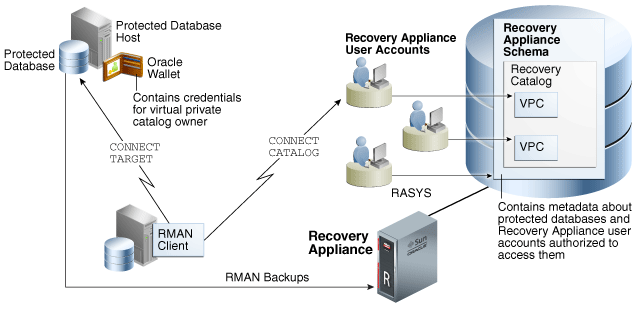Overview of Protected Database Access
A database is not protected by a Recovery Appliance until it can access the database backups.
Performing necessary configuration so that a protected database can send backups to Recovery Appliance is called enrolling a database. Enrolling is a one-time task that must be performed the first time you set up a protected database to use Recovery Appliance. This task requires configuration on both the Recovery Appliance and the protected database.
The basic enrollment steps are as follows:
-
Adding the database
The process of adding a database to a Recovery Appliance adds metadata for the database to the Recovery Appliance metadata database, and assigns this database to the specified protection policy. The result of running
DBMS_RA.ADD_DBis that a non-protected database attains the status of a protected database. -
Granting access to the database to a Recovery Appliance User Account
After you create a virtual private catalog account (the Recovery Appliance user) in the metadata database, run
DBMS_RA.GRANT_DB_ACCESSon the Recovery Appliance to associate this account with the protected database. -
Registering the database with the virtual private catalog
On the protected database host, create an Oracle wallet, and then add the credentials of the virtual private catalog account. Register the protected database with the recovery catalog using the RMAN
REGISTER DATABASEcommand.Note:
If you choose to configure real-time redo transport, then you must execute several SQL statements on the protected database (see Zero Data Loss Recovery Appliance Protected Database Configuration Guide).
Figure 8-1 shows an RMAN client connecting to a protected database (CONNECT TARGET) and to the virtual private catalog (CONNECT CATALOG). For backup and restore operations to be possible, the credentials for the virtual private catalog owner must exist in the Oracle wallet on the protected database host.
It is possible for a database to store metadata in the Recovery Appliance catalog without backing up files to Recovery Appliance. In this case, the databases do not have the status of protected databases, and thus are not enrolled with Recovery Appliance. Future enrolling of such databases is simplified because the virtual private catalog owner already exists, and thus does not need to be created.
